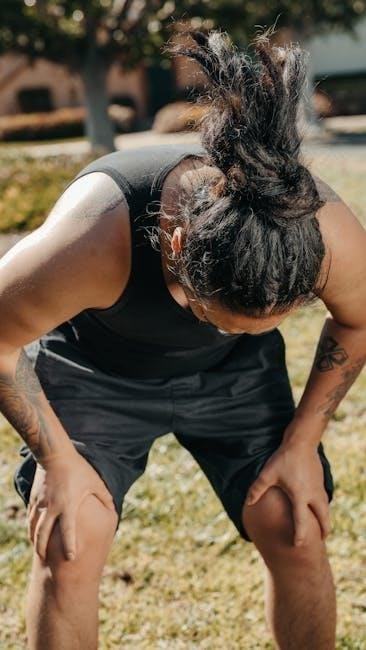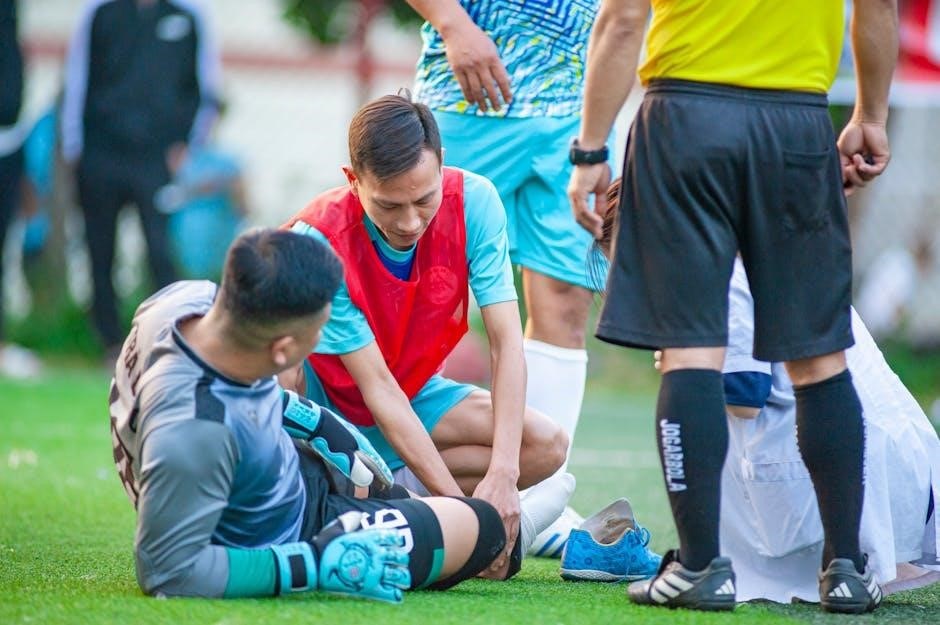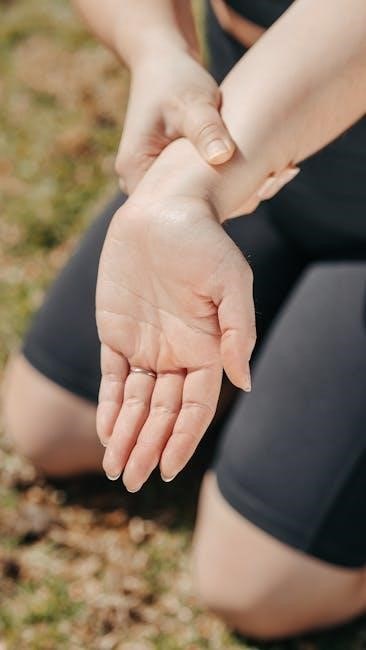Rotator cuff injury exercises are essential for recovery and rehabilitation of the shoulder joint, providing relief from pain and inflammation, and improving overall mobility and function, through various exercises.
Understanding the Importance of Exercise in Recovery
Exercise plays a crucial role in the recovery process of rotator cuff injuries, as it helps to improve flexibility, strength, and mobility of the shoulder joint. Through a well-structured exercise program, individuals can expect to see significant improvements in their range of motion, reduction in pain and inflammation, and enhanced overall function. The importance of exercise in recovery cannot be overstated, as it enables individuals to regain control over their shoulder movements, preventing further injury and promoting long-term health. By incorporating exercises into their daily routine, individuals can take an active role in their recovery, fostering a sense of empowerment and control over their condition, which is essential for a successful and sustainable recovery, and a return to normal activities and daily life. Regular exercise also helps to prevent complications and reduce the risk of future injuries.

Types of Rotator Cuff Injuries
Rotator cuff injuries include strains and tears, with varying degrees of severity, affecting the muscles and tendons, requiring different treatment and exercise approaches always.
Causes and Symptoms of Rotator Cuff Strains and Tears
Rotator cuff strains and tears can be caused by various factors, including repetitive motions, falls, and direct blows to the shoulder. The symptoms of these injuries can vary, but common signs include pain, weakness, and limited mobility in the affected arm. People may experience difficulty lifting their arm or performing daily activities, and some may hear a snapping or cracking sound when moving their shoulder. According to medical research, the most common causes of rotator cuff injuries are related to sports, work, and age-related wear and tear. A proper diagnosis is essential to determine the severity of the injury and develop an effective treatment plan, which may include physical therapy, medication, and in some cases, surgery, to alleviate symptoms and promote healing, with the goal of restoring normal function and mobility to the shoulder joint.
Benefits of Exercise for Rotator Cuff Injuries
Exercises provide pain relief and improve shoulder function and mobility significantly.
Improving Flexibility and Strength through Exercise
Improving flexibility and strength through exercise is crucial for rotator cuff injury recovery, as it enables the shoulder joint to move freely and perform daily activities with ease, reducing the risk of further injury.
Exercise programs typically include a combination of stretching and strengthening exercises, such as shoulder rotations, arm circles, and wall slides, which help to improve range of motion and strengthen the surrounding muscles.
Regular exercise can also help to reduce pain and inflammation, promoting overall shoulder health and function, and can be modified to suit individual needs and abilities, making it an essential component of rotator cuff injury rehabilitation and prevention.
By incorporating exercise into daily routine, individuals can improve their overall quality of life and reduce the risk of future rotator cuff injuries, and can be done with the help of a physical therapist or through self-directed programs.

Common Rotator Cuff Injury Exercises
Exercises include shoulder rolls and stretching to improve flexibility and range of motion, helping to heal the injured rotator cuff muscles and tendons slowly and effectively always.
Pendulum Exercises and Passive Mobilization
Pendulum exercises are a type of exercise that targets the rotator cuff, promoting relaxation and reducing stiffness in the shoulder joint, by using gravity to gently swing the arm.
These exercises are typically performed with the patient leaning forward, allowing their arm to dangle and swing freely, while the therapist or patient applies gentle guidance to facilitate movement.
Passive mobilization is another technique used to improve range of motion, where the therapist applies gentle force to move the patient’s shoulder joint through various movements, helping to reduce pain and inflammation, and improve overall mobility and function, through a series of gentle and controlled movements, promoting healing and rehabilitation of the rotator cuff.
The goal of these exercises is to promote relaxation, reduce stiffness, and improve range of motion, ultimately aiding in the recovery and rehabilitation of the rotator cuff.
With regular practice, patients can experience significant improvements in their shoulder mobility and function.

Progressing to More Advanced Exercises
Advanced exercises include resistance bands and weightlifting to strengthen the muscles, improving flexibility and range of motion, and enhancing overall shoulder function and stability gradually.
Resistance Band and Weightlifting Exercises for Rotator Cuff Rehabilitation
Resistance band and weightlifting exercises play a crucial role in rotator cuff rehabilitation, as they help improve strength and flexibility in the shoulder joint. Using resistance bands or light weights, individuals can perform exercises such as shoulder rotations, lateral raises, and front raises, which target the muscles of the rotator cuff. These exercises can be modified to suit different levels of fitness and mobility, making them accessible to a wide range of individuals. By incorporating resistance! band and weightlifting exercises into their rehabilitation routine, individuals can expect to see significant improvements in their overall shoulder function and reduction in pain and inflammation, ultimately leading to a successful recovery from rotator cuff injury, with a focus on proper technique and gradual progression.

Creating a Personalized Exercise Plan
A customized plan with specific goals and exercises helps individuals recover from rotator cuff injuries effectively and safely, using online resources like rotator cuff injury exercises pdf guides always.
Setting Goals and Tracking Progress in Rotator Cuff Injury Recovery
Setting realistic goals is crucial in rotator cuff injury recovery, allowing individuals to monitor progress and stay motivated throughout the rehabilitation process, which typically involves a series of exercises and physical therapy sessions. A rehabilitation plan should include specific, measurable, and achievable objectives, such as increasing range of motion, reducing pain, and improving overall function. Tracking progress can be done through regular assessments, using tools like pain scales and range of motion measurements, and by maintaining a recovery journal to record exercises, pain levels, and any challenges encountered. By setting goals and tracking progress, individuals can take an active role in their recovery, making informed decisions about their treatment and rehabilitation, and ultimately achieving a successful outcome, with the help of a healthcare professional and a well-structured exercise program. This approach helps individuals stay focused and committed to their rehabilitation.
Preventing Future Rotator Cuff Injuries
Regular exercise and stretching routines can help prevent future rotator cuff injuries and reduce risk of recurrence, promoting long-term shoulder health and stability naturally always.
Maintenance Exercises and Lifestyle Changes for Long-Term Health
Maintenance exercises and lifestyle changes are crucial for long-term health and preventing future rotator cuff injuries. Regular exercise, such as yoga or Pilates, can help improve flexibility and strength. A healthy diet and adequate sleep are also essential for maintaining overall health. Additionally, making lifestyle changes, such as avoiding heavy lifting or repetitive motions, can help reduce the risk of injury. It is also important to stay hydrated and manage stress levels. By incorporating these habits into daily life, individuals can reduce their risk of future injury and maintain optimal shoulder health. Furthermore, consulting with a healthcare professional or physical therapist can provide personalized guidance on maintenance exercises and lifestyle changes. This can help individuals develop a tailored plan to support their long-term health and well-being, and prevent future rotator cuff injuries from occurring. Proper techniques are necessary.
